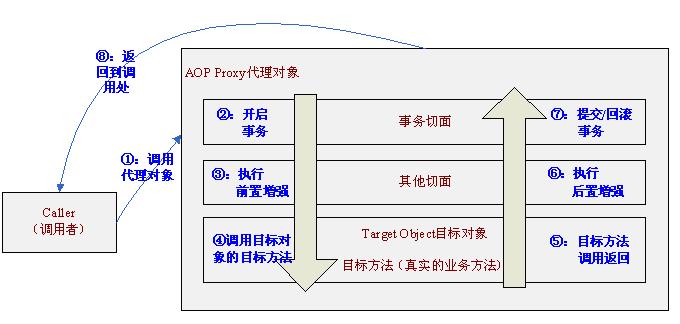现在说下Springd事务。在Spring中提供俩种事务管理方式。1、通过annotation(注解)的方式来声明事务,也称声明式事务;2、通过xml配置文件(aop技术)来实现事务。

现在说下Springd事务。在Spring中提供俩种事务管理方式。
1、通过annotation(注解)的方式来声明事务,也称声明式事务;
2、通过xml配置文件(aop技术)来实现事务。
下面是事务的配置文件:
<?xml version="1.0" encoding="UTF-8"?>
<beans xmlns="https://www.springframework.org/schema/beans"
xmlns:xsi="https://www.w3.org/2001/XMLSchema-instance"
xmlns:context="https://www.springframework.org/schema/context"
xmlns:aop="https://www.springframework.org/schema/aop"
xmlns:tx="https://www.springframework.org/schema/tx"
xsi:schemaLocation="https://www.springframework.org/schema/beans
https://www.springframework.org/schema/beans/spring-beans-2.5.xsd
https://www.springframework.org/schema/context https://www.springframework.org/schema/context/spring-context-2.5.xsd
https://www.springframework.org/schema/aop https://www.springframework.org/schema/aop/spring-aop-2.5.xsd
https://www.springframework.org/schema/tx https://www.springframework.org/schema/tx/spring-tx-2.5.xsd">
<bean id="dataSource"
class="org.apache.commons.dbcp.BasicDataSource"
destroy-method="close">
<property name="driverClassName" value="org.gjt.mm.mysql.Driver" />
<property name="url" value="jdbc:mysql://localhost:3306/test?userUnicode=true&characterEncoding=UTF-8" />
<property name="username" value="root" />
<property name="password" value="5" />
<!-- 连接池启动时的初始值 -->
<property name="initialSize" value="1" />
<!-- 连接池的最大值 -->
<property name="maxActive" value="500" />
<!-- 最大空闲值.当经过一个高峰时间后,连接池可以慢慢将已经用不到的连接慢慢释放一部分,一直减少到maxIdle为止 -->
<property name="maxIdle" value="2" />
<!-- 最小空闲值.当空闲的连接数少于阀值时,连接池就会预申请去一些连接,以免洪峰来时来不及申请 -->
<property name="minIdle" value="1" />
</bean>
<!-- 1.注解方式配置事务 -->
<bean id="txManager" class="org.springframework.jdbc.datasource.DataSourceTransactionManager">
<property name="dataSource" ref="dataSource" />
</bean>
<tx:annotation-driven transaction-manager="txManager" />
<!-- 2.xml方式配置事务.利用aop技术
<aop:config>
<aop:pointcut id="transactionPointcut" expression="execution(* com.test.service..*.*(..))"/>
<aop:advisor advice-ref="txAdvice" pointcut-ref="transactionPointcut"/>
</aop:config>
<tx:advice id="txAdvice" transaction-manager="txManager">
<tx:attributes>
<tx:method name="get*" read-only="true" propagation="NOT_SUPPORTED"/>
<tx:method name="*"/></tx:attributes>
</tx:advice>
-->
<bean id="personService" class="com.test.service.impl.PersonServiceImpl">
<property name="dataSource" ref="dataSource"></property>
</bean>
</beans>
我一般采用的是注解方式,因为比较简单一点。
spring广告位
配置文件里声明启用注解事务之后,看下面代码
package com.test.service.impl;
import java.util.List;
import javax.sql.DataSource;
import org.springframework.jdbc.core.BeanPropertyRowMapper;
import org.springframework.jdbc.core.simple.ParameterizedBeanPropertyRowMapper;
import org.springframework.jdbc.core.simple.SimpleJdbcTemplate;
import org.springframework.transaction.annotation.Propagation;
import org.springframework.transaction.annotation.Transactional;
import com.test.bean.Person;
import com.test.service.PersonService;
@Transactional
public class PersonServiceImpl implements PersonService {
private SimpleJdbcTemplate simpleJdbcTemplate;
public void setDataSource(DataSource dataSource) {
this.simpleJdbcTemplate = new SimpleJdbcTemplate(dataSource);
}
// 两种例外
// 1.unchecked 默认回滚事务(RuntimeException)
// 2.checked 默认不回滚事务(Exception)
// 开启事务.并设置unchecked例外不回滚
@Transactional(propagation = Propagation.REQUIRED, noRollbackFor = RuntimeException.class)
public void delete(int id) {
simpleJdbcTemplate.update("delete from person where id=?",
new Object[] { id });
throw new RuntimeException("运行期例外");
}
/**
* 说下事务的传播属性
* REQUIRED
* (默认)业务方法需要在事务中运行,如果方法运行的时候已经开启事务,就加入事务,否则创建新的事务
* NOT_SUPPORTED
* 声明方法不需要开启事务.如果已经开启事务后调用该方法.则先挂起该事务,方法执行完毕后,事务恢复
* REQUIRES_NEW
* 不管是否存在事务,都另行开启新的事务.如果先前已经开启事务,挂起原先事务.创建新的事务.
* 新的事务执行结束后,恢复原先事务
* MANDATORY
* 只能在已经存在的事务中执行,不能自行创建事务,如果在没有开启事务的环境下调用,容器抛出例外
* SUPPORTS
* 墙头草,有事务就在事务中执行.没事务就在没事务的环境下执行
* NEVER
* 绝对不能在事务中执行.如果执行.抛出例外
* NESTED
* 如果有事务存在,开启一个新事务嵌套在上层事务中.开启的新事务具有自己独立的回滚点.新事务的回滚不会对外部事务造成影响,
* 但是外部事务的提交会直接提交嵌套事务
* 如果没有事务存在,则按照REQUIRED属性执行,该属性只对DataSourceTransationManager事务管理器有效
*/
@Transactional(propagation = Propagation.NOT_SUPPORTED)
// 不开启事务
public Person getPerson(int personId) {
return simpleJdbcTemplate.queryForObject(
"select * from person where id=?",
ParameterizedBeanPropertyRowMapper.newInstance(Person.class),
personId);
}
@Transactional(propagation = Propagation.NEVER)
// 不能在事务环境下执行
@SuppressWarnings("unchecked")
public List<Person> getPersons() {
String sql = "select * from person";
List persons = simpleJdbcTemplate.getJdbcOperations().query(sql,
new BeanPropertyRowMapper(Person.class));
return persons;
}
@Transactional(propagation = Propagation.NEVER)
public void save(Person person) {
simpleJdbcTemplate.getJdbcOperations().update(
"insert into person(name) values(?)",
new Object[] { person.getName() },
new int[] { java.sql.Types.VARCHAR });
}
public void update(Person person) {
simpleJdbcTemplate.getJdbcOperations().update(
"update person set name=? where id=?",
new Object[] { person.getName(), person.getId() },
new int[] { java.sql.Types.VARCHAR, java.sql.Types.INTEGER });
}
}









